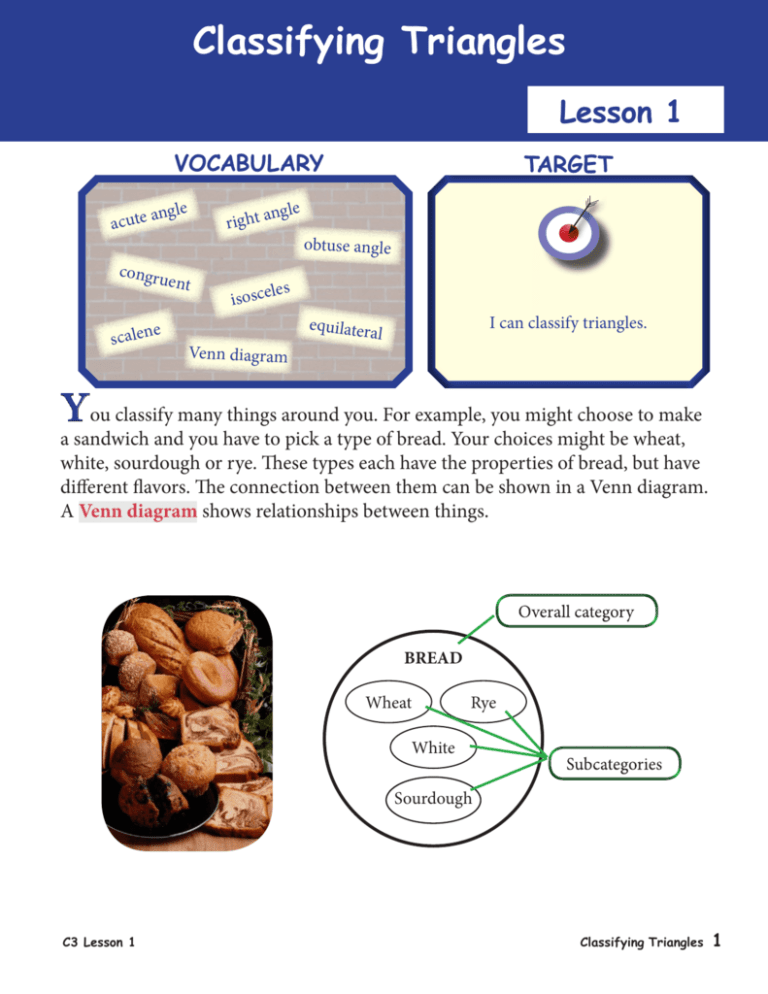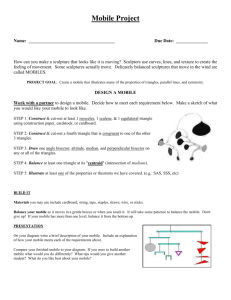Classifying Triangles
advertisement

Classifying Triangles Lesson 1 VOCABULARY e ngle right a angl acute congru ent e scalen TARGET obtuse angle es l isosce Venn diagram equilatera I can classify triangles. l You classify many things around you. For example, you might choose to make a sandwich and you have to pick a type of bread. Your choices might be wheat, white, sourdough or rye. These types each have the properties of bread, but have different flavors. The connection between them can be shown in a Venn diagram. A Venn diagram shows relationships between things. BREAD Wheat Rye White Sourdough C3 Lesson 1 Classifying Triangles 1 Sometimes the relationships shown on a Venn diagram do not all fit into one category like bread. Suppose a Venn diagram is used to show multiples of 2 and multiples of 3 within the numbers 1−25. A Venn diagram like the one below might be used. Multiples of 2 2 4 Multiples of 3 6 8 10 12 14 16 18 20 22 24 3 9 15 21 Why do the two circles in the Venn diagram overlap? If the Venn Diagram showed multiples of 2 and multiples of 3 within the numbers 1−36, what other numbers would be in the overlap of the two circles? In this lesson you will use attributes of two-dimensional shapes to classify triangles. One way to show the relationships between types of triangles will be with a Venn diagram. A triangle is a polygon with three sides. There are many types of triangles. Each triangle can be classified by its angle types and its number of sides with equal lengths. Angles in a triangle can be acute, right or obtuse. When the sides of a triangle are equal in length, they are congruent. Congruent figures are the exact same size and shape. 2 Classifying TrianglesC3 Lesson 1 Acute Angle Right Angle Obtuse Angle An acute angle measures between 0° and 90°. It is smaller than a right angle. A right angle measures 90°. An obtuse angle measures between 90° and 180°. It is larger than a right angle. The charts below show how to classify a triangle by its angles and sides. Classify Triangles Using Sides Scalene Triangle: no congruent sides Isosceles Triangle: at least 2 congruent sides Equilateral Triangle: 3 congruent sides Classify Triangles Using Angles Acute Triangle: 3 acute angles Right Triangle: 1 right angle Obtuse Triangle: 1 obtuse angle C3 Lesson 1 Classifying Triangles 3 An equilateral triangle is also a special isosceles triangle. It has at least two congruent sides. Triangles Scalene Isosceles Equilateral Use both the angle and side names when classifying a triangle. The chart below shows an example of each type of triangle when it is classified by its sides and angles. Scalene Acute 60° 7 80° 10 Right 53° 4 Obtuse 12 60° 4 100° 20° 11 8 acute isosceles triangle 4 45° 7 60° 60° 7 7 60° equilateral triangle 5.7 37° right scalene triangle Equilateral 70° 70° 5 40° 5 40° 8 11 acute scalene triangle 3 Isosceles 4 45° Not possible right isosceles triangle 6 110° 6 35° 35° 10 Not possible obtuse scalene triangle obtuse isosceles triangle 4 Classifying Triangles C3 Lesson 1 Classify the triangles below using angles and sides. Circle the angle name and the side name. acuterightobtuse scaleneisoscelesequilateral acuterightobtuse scaleneisoscelesequilateral The names for the triangles below show how to classify triangles. 10 10 10 C3 Lesson 1 Classifying Triangles 5 Draw two triangles that fit each part of the Venn diagram below. Acute Triangles Match each description to part of the Venn diagram above by drawing a line from the rectangle to the correct section of the Venn diagram. Triangles that are acute and scalene. Scalene Triangles Triangles that are acute and not scalene. Triangles that are scalene and not acute. Valerie says an equilateral triangle can also be called an isosceles triangle. Is she correct? Explain your reasoning. 6 Classifying Triangles C3 Lesson 1 Name: Practice 1. Circle the acute triangles. 40° 40° 40° 60° 100° 70° 80° 80° 50° 50° 20° 2. Circle the scalene triangles. 12 9 5 4 7 4 8 10 6 8 8 4 3. Circle the obtuse isosceles triangles. 7 40° 5 35° 120° 10 70° 70° 4 110° 5 8 5 67° 35° 13 12 130° 25° 25° 23° 4. Classify each triangle by its angles and sides. 55° 20 40° 70° 8 55° ___________ ___________ 120° 15 20° ____________ ___________ C3 Lesson 1 Classifying Triangles 7 5. Can you draw an obtuse right triangle? ________ why not. If so, draw it. If not, explain 6. Can you draw a right isosceles triangle? ________ If so, draw it. If not, explain why not. 7. Circle the equilateral triangles. 5 6 5 4 9 8 7 9 9 5 3 60° 7 60° 60° 8. For each statement, circle ALWAYS, SOMETIMES or NEVER. a. A right triangle is isosceles. ALWAYS SOMETIMES NEVER b. An obtuse triangle has three obtuse angles. ALWAYS SOMETIMES NEVER c. An equilateral triangle is isosceles. ALWAYS SOMETIMES NEVER 8 Classifying Triangles C3 Lesson 1 9. Draw two triangles that fit each part of the Venn diagram below. Isosceles Triangles Right Triangles 10. Two sides of a triangle have lengths of 10 inches. The third side has a length of 8 inches. What is the best name for the triangle? Use a picture and/or words to explain your answer. 11. Lyle drew the Venn diagram to the right. a. Why is the circle with the name “Equilateral” inside the circle named “Isosceles”? Triangles Isosceles Scalene Equilateral b. Why don’t the circles named “Scalene” and “Isosceles” overlap? C3 Lesson 1 Classifying Triangles 9






